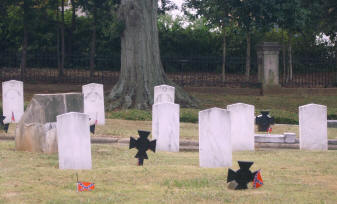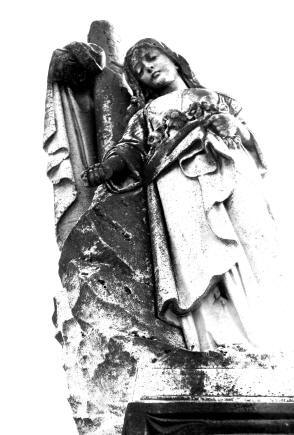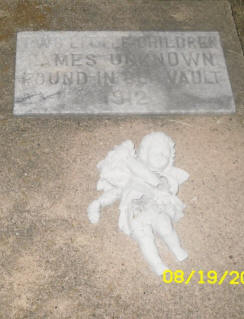“Pure logic is the ruin of the spirit.” `~~Antoine de Saint-Exupery (French Pilot, Writer and Author of 'The Little Prince', 1900-1944)
| Decoding Graveyard Symbology Aristotle observed that "the aim of art is to represent not the outward appearance of things, but their inward significance." It is doubtful that when he gave forth this profound nugget of philosophy he specifically had in mind funeral customs, yet in the intervening millennia between the first pagan stone and earthen burial mounds (tumuli) and the laser-etched, computer-designed monuments to individualism of today, no other ritual of life has been more closely tied to art and artistic symbolism than death.
 Dying is the final act of every mortal and, as such, carries weighty significance for each who will face it. No matter the emotion, be it fear, resignation, despair or the anticipation of sloughing off a fleshly shell preparatory to spiritual ascendancy, death can not, indeed, should not, be viewed objectively. Still it is a very human desire as we each make the inevitable journey into the unknown that we leave behind a memento of remembrance, a way to ensure we are not forgotten, an enduring statement that we were. Thus rose the art and architecture of the cemetery. Dying is the final act of every mortal and, as such, carries weighty significance for each who will face it. No matter the emotion, be it fear, resignation, despair or the anticipation of sloughing off a fleshly shell preparatory to spiritual ascendancy, death can not, indeed, should not, be viewed objectively. Still it is a very human desire as we each make the inevitable journey into the unknown that we leave behind a memento of remembrance, a way to ensure we are not forgotten, an enduring statement that we were. Thus rose the art and architecture of the cemetery.
None but a select few have the honor and affluence accorded them wherein to spend eternity enshrined within a Taj Mahal or a Great Pyramid, a royal vault within the consecrated walls of Westminster Abbey, or a papal tomb in the Vatican sculpted by Michelangelo. The lack of means and, frequently, space, coupled with low literacy rates necessitated the evolution of stylized symbols which effectively paid homage to the departed while also allowing the living to gain an insight upon the decedent's nature, faith, trade, fraternal associations or philosophy. Art is an universal language, needing no translation.
 That is not to say that funereal expressions have remained unchanging or that all symbols will be interpreted alike by all persons. Cultural, ethnic and religious influences serve to have the greatest impact upon graveyard art, but the meaning of most symbols have remained relatively constant down through history. Crosses, whether Latin, Greek or Celtic, are most strongly associated with Christianity, as the six-pointed Star of David is similarly connected with Judaism. The death's head equates finality, while a lamb, often found on a child's plot, indicates purity and innocence. A square and compass likely means a Masonic affiliation, while drapery means mourning and a curtain symbolizes the passage from a worldly existence into the veiled spiritual realm. That is not to say that funereal expressions have remained unchanging or that all symbols will be interpreted alike by all persons. Cultural, ethnic and religious influences serve to have the greatest impact upon graveyard art, but the meaning of most symbols have remained relatively constant down through history. Crosses, whether Latin, Greek or Celtic, are most strongly associated with Christianity, as the six-pointed Star of David is similarly connected with Judaism. The death's head equates finality, while a lamb, often found on a child's plot, indicates purity and innocence. A square and compass likely means a Masonic affiliation, while drapery means mourning and a curtain symbolizes the passage from a worldly existence into the veiled spiritual realm.
But what is one supposed to think upon encountering a winged ox, a granite tree stump bare of branches or a roughly hewn giant boulder next to an otherwise well-kept tomb? Can the assumption be made that the departed was stubborn and given to flights of fancy? Perhaps one was a lumberjack in life? Was the stone too heavy to be removed and thus the savvy occupant (or like-minded relatives) negotiated a reduction in the cost of the plot? Hardly! Upon closer observation and perhaps aided by a simple primer in the fundamentals of graveyard art, the cemetery visitor can discover the true implications of such seeming esoterica.
 The winged ox is representative of the evangelist St. Luke and signifies sacrifice and service. The denuded tree, symbolizing equality, is a common memorial for the fraternal Woodmen of the World whose pledge to members even today is "no Woodmen shall rest in an unmarked grave." The unwieldy stone, far from being a blemish upon a less than favorable piece of real estate, refers to the Resurrection of Christ upon the third day as related in Luke 24:2...'And they found the stone rolled away from the sepulchre.' It serves further as a reminder of the Lord's promise that His faithful followers shall also transcend the grave and attain salvation in the Kingdom of Heaven. The winged ox is representative of the evangelist St. Luke and signifies sacrifice and service. The denuded tree, symbolizing equality, is a common memorial for the fraternal Woodmen of the World whose pledge to members even today is "no Woodmen shall rest in an unmarked grave." The unwieldy stone, far from being a blemish upon a less than favorable piece of real estate, refers to the Resurrection of Christ upon the third day as related in Luke 24:2...'And they found the stone rolled away from the sepulchre.' It serves further as a reminder of the Lord's promise that His faithful followers shall also transcend the grave and attain salvation in the Kingdom of Heaven.
Outside of faith-specific iconography, angels are undoubtedly the second most popular form seen among the fields of eternal slumber. A potent symbol, recognized almost universally as divine messengers within every culture, there are three orders of angels, subdivided into nine "choirs". The hierarchies, from most powerful (closest to God) to least, are the Counsellors which include the Seraphim, Cherubim and Thrones; the Governors, consisting of the Dominions, Powers and Virtues, and the Messengers which are populated by the Principalities, Archangels and Angels.
These winged images are depicted in a multiplicity of guises, and being the intermediaries between Heaven and humans, adorn not just cemeteries, but grand cathedrals, temples and imposing halls of justice. Gabriel ready to sound the Horn of Judgment, Michael with flaming sword hefted against the enemies of God and man, jubilant seraphim and dimpled cherubs are all familiar. Most common, however, is the feminine angel, whether saddened or serene, gowned in flowing heavenly robes.
Frequently the seven Virtues are depicted in cemetery sculpture, and often the subtle nuances between them are misconstrued by the undiscerning eye. Despite being of the middle order of angels, they are seldom seen with wings, but there are other clues that help determine their identities. If the lady is seen with a cross, candle or lamp, then she is likely Faith. Hope is often accompanied by an anchor or a boat, symbolic of the voyage to the next realm. Artwork usually shows Charity nursing a child, but chaste Victorian morals damped this suggestive pose to the tamer and less lewd act of her beginning to bare a breast. Even this proved to be more provocative than many of the straitlaced could handle, so a basket of food or a heap of clothing was substituted instead.
 Faith, Hope and Charity are considered the theological Virtues, while the four lesser or cardinal Virtues are Temperance, Fortitude, Justice and Prudence. Temperance, seen with a water pitcher or other type of ewer, usually graces the tomb of a teetotaler or Prohibitionist, and may have with her either a bit and bridle or a sheathed sword indicating control and restraint. Fortitude is often seen as a confident warrior with club, shield and helmet. Justice is more frequently seen on courthouses than in cemeteries, but her unmistakable symbol is the scales. Prudence is rarely found since her two heads and serpent or dragon companions may send the wrong message about the departed, yet when she is located, a less alarming rendering of her is with a mirror and a discreet snake, both of which allude to the quest for knowledge. Faith, Hope and Charity are considered the theological Virtues, while the four lesser or cardinal Virtues are Temperance, Fortitude, Justice and Prudence. Temperance, seen with a water pitcher or other type of ewer, usually graces the tomb of a teetotaler or Prohibitionist, and may have with her either a bit and bridle or a sheathed sword indicating control and restraint. Fortitude is often seen as a confident warrior with club, shield and helmet. Justice is more frequently seen on courthouses than in cemeteries, but her unmistakable symbol is the scales. Prudence is rarely found since her two heads and serpent or dragon companions may send the wrong message about the departed, yet when she is located, a less alarming rendering of her is with a mirror and a discreet snake, both of which allude to the quest for knowledge.
For many, cemetery sleuthing is a hobby, albeit an unusual one. For others it is more. It is a passion, neither macabre nor ghoulish, but beautiful and spiritually uplifting. Venturing into the grounds set aside for eternal rest can also be likened to the fitting together of pieces of a puzzle. Decoding the symbolism can provide an educational insight into not only local history and personalities, but into the evolutionary social, economic, and ethnic values of the neighborhood as well. Though we have explored only a few types of memorials erected to honor the departed, there remains a diverse wealth of others awaiting our discovery. The graveyard is quite literally stories in stone.
So the next time you think on viewing some artwork, rather than a trip to the museum, visit a local cemetery. You'll most likely find it just as pleasant, illuminating and peaceful as any docent led tours... and nowhere near as crowded, unless you consider those already there ahead of you. ~~Janet McDonald, LadyJEM Part 2, Next up:
View this excellent piece on Gravestone Symbolism, created by Beth Santore of the paranormal group Grave Addiction, based in Ohio. 
| What is a Graver? Gravers seek out an individual's grave records finding dates and places of birth and death, biographical information, cemetery and plot information, and such, and will photograph the grave markers, and provide this and other information to their descendants who will then be able to fill in genealogical puzzles important to a family's history. Gravers are volunteers who enjoy the quiet peacefulness of cemeteries as they fulfill a pastime to reunite the living with their departed ancestors. Gone from this plane, perhaps, but not forgotten.......often leaving still so much to share. Part 2:
Next up, Gravestone Symbolism, created by Beth Santore
 Proudly Affiliated with Ghostvillage.com!
|
 Dying is the final act of every mortal and, as such, carries weighty significance for each who will face it. No matter the emotion, be it fear, resignation, despair or the anticipation of sloughing off a fleshly shell preparatory to spiritual ascendancy, death can not, indeed, should not, be viewed objectively. Still it is a very human desire as we each make the inevitable journey into the unknown that we leave behind a memento of remembrance, a way to ensure we are not forgotten, an enduring statement that we were. Thus rose the art and architecture of the cemetery.
Dying is the final act of every mortal and, as such, carries weighty significance for each who will face it. No matter the emotion, be it fear, resignation, despair or the anticipation of sloughing off a fleshly shell preparatory to spiritual ascendancy, death can not, indeed, should not, be viewed objectively. Still it is a very human desire as we each make the inevitable journey into the unknown that we leave behind a memento of remembrance, a way to ensure we are not forgotten, an enduring statement that we were. Thus rose the art and architecture of the cemetery.